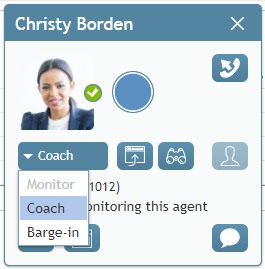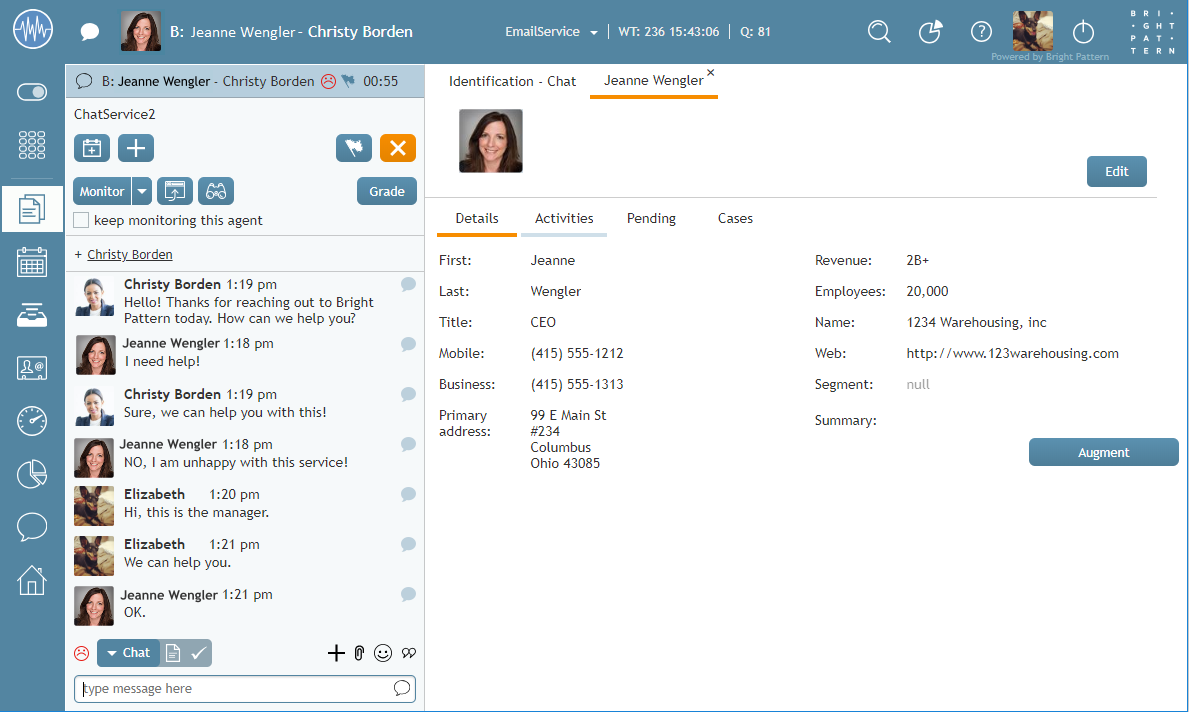Call Monitoring, Coaching, and Barge-In
As a supervisor, you can connect to a service call or chat handled by any member of your team. You can do this in order, for example, to monitor the quality of service or to help an agent with a difficult interaction. Note that the agent may send you a chat message (see section Individual Chat) or flag an interaction that the agent needs immediate help handling. When the interaction is flagged, you will see the flag icon next to the agent’s state in the Agent Metrics View.
Depending on the purpose, you can select one of the following three connection modes:
- Monitor - In this mode, you may observe the interaction. For calls, this means you can hear the conversation between the agent and the customer, but neither of them can hear you; for chats, this means you can observe the interaction as it is happening. Note that the agent will not have any indication that his interaction is being monitored. However, if you wish to make a suggestion for the agent, you can do this using chat.
- Coach - In this mode, you may provide feedback to agents while observing the interaction. For calls, this means you can hear the conversation between the agent and the customer, and you can talk to the agent. The agent will hear you, but the customer will not. For chats, this means you can see the chat as it is happening and chat with the agent without any indication to the customer.
- Barge-in - In this mode, both the customer and the agent will hear you speak or see you chat and will be able to interact with to you.
You can connect to a service call or chat using any of the above modes, and you can switch from one mode to another at any time and any number of times during the same interaction. For example, if an agent sends you a chat message requesting help with a difficult call, you can first listen to the call in Monitor mode and then, depending on your assessment of the situation, either switch to Coach mode to provide instructions to the agent or activate Barge-in mode to participate actively in the conversation with the customer.
How to Turn On/Off Supervision Modes
To activate one of the supervision modes:
- Select an agent from the Agent Metrics View in the right pane of Agent Desktop. The agent must be handling an active interaction and be in the Busy state.
- The Contact Info Panel will display the monitoring functions.
- If the Monitor/Coach/Barge-in button displays the desired supervision mode, click the button.
- If you wish to be connected in a different supervision mode, click the arrow section of the Monitor/Coach/Barge-in button, and select the desired supervision mode from the drop-down menu.
When you are connected to an interaction in a particular supervision mode, the Monitor/Coach/Barge-in button will display the “next” supervisor mode (i.e., if the current mode is Monitor, the button will display Coach, and so on).
- To switch to this “next” mode, click the button itself.
- To switch to a different supervision mode (e.g., from Monitor directly to Barge-in), click the arrow section of and select the desired supervision mode from the drop-down menu.
If on a call, the system will automatically start call recording as soon as you connect to this call in any supervisor mode. Note also that the system supports simultaneous monitoring of one agent by more than one supervisor.
To stop the supervision activity for this call:
Click the End Call button.
How to View Agents' Context Information Area
At any time during call supervision, you can view the content of the Context Information Area of the monitored agent’s desktop. If this area is used to show any customer data related to the call, this may help you understand the context of the agent-customer interaction. To get the content of the Context Information Area of the agent’s desktop, click the Pull screen button ![]() .
.
Note that the screen you will see is the screen that the agent received via screen pop (i.e., if the agent has changed screens after the initial screen pop, you will not see those changes). To monitor an agent's screen in real time, use the screen monitoring function.



